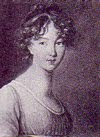This pattern comes
from Weldon’s Practical Knitter, Number 17, Fifth Series (1887). It is also
published in Weldon’s Practical Needlework, Volume 2, Interweave Press, 2000.
There is no actual
pattern for the comb bag, only a suggestion and stitch count to make this case
at the end of the Nightdress Case pattern in the same edition.
The original
pattern for the Nightdress Case calls for “Strutt’s knitting cotton, No. 6” and
“a pair of steel needles No. 12” (modern equivalent 2.50mmmm/US 2. No gauge or
tension or finished size is stated. This bag would certainly hold a small
hairbrush and comb, and a few other accessories for the hair but not one of
those lovely large brush and comb sets from the 19th century. Both
cases are knit into a zigzag lace strip fabric which is trimmed with a lace
edge whose pattern is included in the one for the Nightdress Case. The cases
should be lined with “pink sateen.”
I had originally
started the Nightdress Case in white thread some years ago but changed to this
lovely powder blue after discovering it last winter. Both bags are being knit
on on 2.5mm/US 2 size needles, using Aunt Lydia’s Classic Crochet thread (Size
10) in Delft. I have the Nightdress Case on the needles, too, with the same
thread, but I thought this smaller bag was a good warm up exercise for the
larger project. A good thing, too, as perhaps I can make myself pay more
attention to the larger case since there are glaring errors in the lower front
part of the lace trim of this bag. I can only say that knitting lace in a poor
light is a bad idea and advise that all handwork should be checked every now
and then during its production.
The bag measures 8”
x 5 ¼”, or 7 ¼” by 11” including the lace border. It is lined with pink
imitation silk and trimmed “with strings of pink ribbon to draw.”*
*Weldon’s Practical
Knitter, Number 17, Fifth Series (1887)













